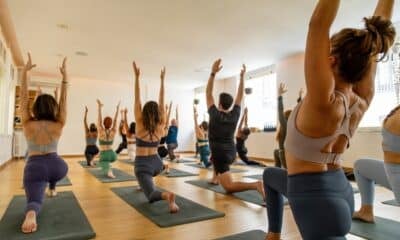No More Worries About Post-Workout Stretches
As a former dancer, I used to believe that the key to my performance was stretching as much as possible. Flexibility seemed pivotal for achieving the perfect high kicks and graceful backbends. I found myself stretching incessantly: before class, during any breaks, after class, and while relaxing at home.
Eventually, I discovered that it’s not recommended to overdo static stretching before physical activity. Yet, I continued to stretch compulsively after fitness classes, following a run, and during my evening unwind—long after my dance days were behind me and my fitness aspirations shifted to simply living an active, injury-free life.
Despite the harmless nature of my excessive stretching, considering my inherent flexibility and absence of mobility issues, it likely didn’t lend much benefit. Nonetheless, stretching felt like a workout staple, seemingly as essential as the workout itself, creating the illusion that no fitness routine was complete without it.
Even though stretching plays an integral role in a balanced fitness regimen, for those who remain active regularly, it’s perfectly fine to skip some of those post-exercise stretches. Per the American College of Sports Medicine (ACSM), stretching merely two or three times a week is sufficient for maintaining muscle health and joint flexibility, with the timing of these stretches being relatively inconsequential.
Yet, amidst stretching’s rising popularity, both as an addition to workouts and as its own form of exercise, and the flood of fitness advice on social media, many have come to view stretching as a panacea for all physical discomfort or the secret to optimizing recovery.
In reality, while stretching is indeed useful, we don’t need much of it to enjoy its advantages. So what’s the deal with our collective stretching guilt?
The Purpose Behind Stretching
Stretching’s main goal is to enhance our body’s movement capabilities. According to Heather Milton, RCEP, CSCS, an exercise physiologist at NYU Langone’s Sports Performance Center, how stretching achieves this depends on the type of stretching you’re doing.
Dynamic stretches like hip circles or arm swings are about moving your joints through their full range. They prep us for working out by waking up our muscles, lubricating the joints, and warming the body, allowing us to move smoothly through our exercise routines.
On the contrary, static stretches—those typical toe-touches or held lunges—are geared towards sustaining or improving our flexibility over the long term. They can be crucial for combating tightness from repetitive motions, prolonged sitting, or simply aging.
In layman’s terms, stretching empowers our bodies to reach their full motion potential, and without it, we could encounter issues such as compensatory injuries, as exercise physiologist Tom Holland, CSCS, CISSN, explains. Such issues occur when your body must compensate for the tightness or immobility elsewhere, disrupting natural movement and potentially leading to injuries.
Delineating Stretching, Warming Up, and Cooling Down
Despite commonly lumping stretching, warming up, and cooling down together, each serves distinct roles in maximizing our exercise routines and maintaining injury prevention. However, this confusion often muddles when and why we should stretch.
For example, one might observe runners stretching their calves against a tree before a race, intending to warm up. According to Milton, such static stretches don’t warm you up; in fact, staying static doesn’t generate body heat by definition. Research even suggests that static stretching before exercise can temporarily weaken muscles by up to 10 percent, potentially increasing the risk of injury.
Contrastingly, a proper warmup involves activity-specific dynamic stretches and light cardio like high knees or jogging in place. Its purpose? To get blood pumping and warm the body up, Holland notes.
Milton further explains warmups as the gradual shift from rest to activity. Cool-downs, then, represent the opposite transition. Instead of stretching, cool-downs involve gradually easing your body from the high-energy state of exercise into a restful state, aiming to switch from an active sympathetic nervous state to a relaxed parasympathetic state for recovery.
While static stretching can be a part of your cool-down, it isn’t a must. Alternatives like deep breathing, post-exercise meditation, or a calm post-exercise walk can better help in switching out of workout mode.
What Stretching Achieves and What It Doesn’t
It makes practical sense to incorporate stretching after a workout when the body is already supple from exertion. However, the timing of stretching, whether it be right after a workout or later while you’re enjoying a television show, isn’t of significant consequence, explains Gregory Rubin, DO, a sports medicine physician. Stretching right after doesn’t prevent injuries, speed recovery, decrease muscle soreness, or lower the risk of repetitive use injuries.
What stretching can effectively do is help avoid those injuries and discomforts that come from overly tense muscles or a lack of mobility,
If you feel tightness or pain, such as in the hamstrings or lower back, stretching might seem like an obvious solution. However, physical therapist Ari Kaplan, PT, DPT, cautions that it is important not to assume stretching is a cure-all for these discomforts. At times, tightness serves as a protective response by our body to a different underlying issue that stretching alone may not address.
“When our stretches do not result in improved movement or lasting relief, it’s typically a sign that there’s a deeper underlying problem, like a structural imbalance or muscle overuse,” Kaplan explains.
Optimal Stretching: How Much and When?
Reflecting on my previous stretching habits, I realize that I once held the false belief that increased flexibility would inherently make me healthier and more fit. However, the truth is that most activities only require enough flexibility to support our natural range of motion. Attempting to achieve excessive flexibility can lead to injuries, especially once you realize that “the limitation may come from joint, not muscle flexibility—and this is natural,” notes Milton.
The pursuit of extreme flexibility can introduce its own set of problems. “Greater flexibility can make joints more prone to injuries,” states Holland. And beyond a certain extreme, flexibility can undermine strength, as “muscles can be stretched to a point where they lose power, adversely affecting athletic performance,” explains Dr. Rubin.
So when it comes to the right amount and timing for stretching, Milton suggests including dynamic stretches as a key part of your warmup routine before physical activities or exercises.
Regarding static stretches, unless you have specific mobility limitations or injuries, aim to integrate them into your activities several times a week—post-exercise or at another suitable time when your body is warmed up. A duration of 15 to 30 seconds for each stretch is typically sufficient, as recommended by various studies, and targeting all major muscle groups should be a brief process.
Be cautious to stretch only until you feel a slight discomfort and avoid any stretching that causes pain. An indicator that you’re stretching too far is the need to hold your breath during the stretch, according to Milton. She emphasizes that stretching should be seen as maintenance for your existing level of mobility, rather than an attempt to significantly increase it, assuming you don’t have notable tightness or restrictions.
Holland remarks, “There’s a common tendency to overdo certain practices in small doses, whereas the right approach is typically to undertake modest activities more frequently. The concept is far simpler than most people assume.”















